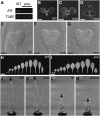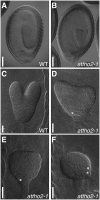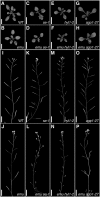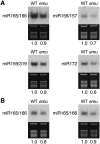Characterization of EMU, the Arabidopsis homolog of the yeast THO complex member HPR1
- PMID: 20668032
- PMCID: PMC2924540
- DOI: 10.1261/rna.2265710
Characterization of EMU, the Arabidopsis homolog of the yeast THO complex member HPR1
Abstract
Diverse and precise control is essential for eukaryotic gene expression. This is accomplished through the recruitment of a myriad of proteins to a nascent messenger RNA (mRNA) to mediate modifications, such as capping, splicing, 3'-end processing, and export. Despite being important for every cell, however, the mechanism by which the formation of diverse messenger ribonucleoprotein (mRNP) particles contributes to maintaining intricate systems in the multicellular organism remains incompletely defined. We identified and characterized a mutant gene named erecta mRNA under-expressed (emu) that leads to the defective mRNA accumulation of ERECTA, a developmental regulator in the model plant Arabidopsis thaliana. EMU encodes a protein homologous to a component of the THO complex that is required for the generation of functional mRNPs. Further analysis suggested that EMU is genetically associated with SERRATE, HYPONASTIC LEAVES1, and ARGONAUTE1, which are required for proper RNA maturation or action. Furthermore, mutations in another THO-related gene led to embryonic lethality. These findings support the presence and importance of the THO-related complex in plants as well as yeast and vertebrates.
Figures






Similar articles
-
HYPER RECOMBINATION1 of the THO/TREX complex plays a role in controlling transcription of the REVERSION-TO-ETHYLENE SENSITIVITY1 gene in Arabidopsis.PLoS Genet. 2015 Feb 13;11(2):e1004956. doi: 10.1371/journal.pgen.1004956. eCollection 2015 Feb. PLoS Genet. 2015. PMID: 25680185 Free PMC article.
-
HPR1, a component of the THO/TREX complex, plays an important role in disease resistance and senescence in Arabidopsis.Plant J. 2012 Mar;69(5):831-43. doi: 10.1111/j.1365-313X.2011.04835.x. Epub 2011 Dec 12. Plant J. 2012. PMID: 22035198
-
Arabidopsis homolog of the yeast TREX-2 mRNA export complex: components and anchoring nucleoporin.Plant J. 2010 Jan;61(2):259-70. doi: 10.1111/j.1365-313X.2009.04048.x. Epub 2009 Oct 16. Plant J. 2010. PMID: 19843313
-
New clues to understand the role of THO and other functionally related factors in mRNP biogenesis.Biochim Biophys Acta. 2012 Jun;1819(6):514-20. doi: 10.1016/j.bbagrm.2011.11.012. Epub 2011 Dec 20. Biochim Biophys Acta. 2012. PMID: 22207203 Review.
-
Diverse roles of ERECTA family genes in plant development.J Integr Plant Biol. 2013 Dec;55(12):1238-50. doi: 10.1111/jipb.12108. Epub 2013 Oct 30. J Integr Plant Biol. 2013. PMID: 24016315 Review.
Cited by
-
The presence of multiple introns is essential for ERECTA expression in Arabidopsis.RNA. 2011 Oct;17(10):1907-21. doi: 10.1261/rna.2825811. Epub 2011 Aug 31. RNA. 2011. PMID: 21880780 Free PMC article.
-
The THO/TREX Complex Component RAE2/TEX1 Is Involved in the Regulation of Aluminum Resistance and Low Phosphate Response in Arabidopsis.Front Plant Sci. 2021 Jul 12;12:698443. doi: 10.3389/fpls.2021.698443. eCollection 2021. Front Plant Sci. 2021. PMID: 34322147 Free PMC article.
-
HOS1 regulates Argonaute1 by promoting transcription of the microRNA gene MIR168b in Arabidopsis.Plant J. 2015 Mar;81(6):861-70. doi: 10.1111/tpj.12772. Epub 2015 Feb 19. Plant J. 2015. PMID: 25619693 Free PMC article.
-
The THO/TREX Complex Active in miRNA Biogenesis Negatively Regulates Root-Associated Acid Phosphatase Activity Induced by Phosphate Starvation.Plant Physiol. 2016 Aug;171(4):2841-53. doi: 10.1104/pp.16.00680. Epub 2016 Jun 21. Plant Physiol. 2016. PMID: 27329222 Free PMC article.
-
Pre-mRNA Splicing in Plants: In Vivo Functions of RNA-Binding Proteins Implicated in the Splicing Process.Biomolecules. 2015 Jul 24;5(3):1717-40. doi: 10.3390/biom5031717. Biomolecules. 2015. PMID: 26213982 Free PMC article. Review.
References
-
- Alonso JM, Stepanova AN, Leisse TJ, Kim CJ, Chen H, Shinn P, Stevenson DK, Zimmerman J, Barajas P, Cheuk R, et al. 2003. Genome-wide insertional mutagenesis of Arabidopsis thaliana. Science 301: 653–657 - PubMed
-
- Bartel DP 2004. MicroRNAs: Genomics, biogenesis, mechanism, and function. Cell 116: 281–297 - PubMed
-
- Barton MK, Poethig RS 1993. Formation of the shoot apical meristem in Arabidopsis thaliana: An analysis of development in the wild type and in the shoot meristemless mutant. Development 119: 823–831
-
- Bezerra IC, Michaels SD, Schomburg FM, Amasino RM 2004. Lesions in the mRNA cap-binding gene ABA HYPERSENSITIVE 1 suppress FRIGIDA-mediated delayed flowering in Arabidopsis. Plant J 40: 112–119 - PubMed
Publication types
MeSH terms
Substances
LinkOut - more resources
Full Text Sources
Molecular Biology Databases
